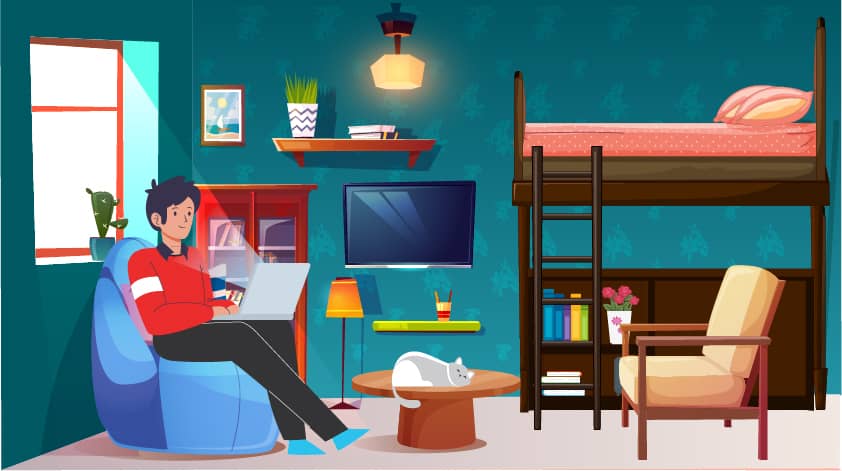How To Use Space Efficiently In A Small Home

Just because you don’t have a large home or you’re moving into a small one, you don’t have to compromise on style. Setting up a small home doesn’t always need to result in making it look cluttered, messy, and not to forget, cramped for space. It simply requires design creativity of the next-level and great attention to detail to know what goes and what doesn’t in the available space.
Here are some simple space hacks you can follow to make your tiny place look stylish, organized and more accessible.
{"preview_thumbnail":"/sites/default/files/styles/video_embed_wysiwyg_preview/public/video_thumbnails/XA10PerVajU.jpg?itok=Z_Rc2hgw","video_url":"https://youtu.be/XA10PerVajU","settings":{"responsive":1,"width":"854","height":"480","autoplay":1},"settings_summary":["Embedded Video (Responsive, autoplaying)."]}
#1 Declutter Your Belongings Before Moving
Before relocating to a smaller home, declutter your home and dispose of unneeded items. This simplifies the moving process and helps keep your new space tidy.
Inspect each room and find items you don't need or haven't used for a while. You can sell or donate these items, or replace them with more space-saving options.
Note: Consider renting a storage unit or using a warehouse facility for your excess items. This can provide a temporary solution until you decide what to do with them long-term.
#2 Utilize Multi-functional Furniture
Invest in furniture that serves multiple purposes, such as a sofa bed or a coffee table with storage. This will help you save space while maintaining functionality.
#3 Invest in Foldable Furniture
Folding furniture comes in various types for small rooms, creating extra space to move around. For instance, a loft bed makes room for a desk and chair, allowing your bedroom to serve as a home office with a stylish and cozy layout.
Likewise, you can optimize small spaces at home using foldable tables or chairs. A foldable wall table is a great addition to the kitchen, enhancing functionality while occupying minimal space.
#4 Maximize Vertical Space
Take advantage of vertical space by installing shelves, hooks, and wall-mounted organizers. This will help you store items off the floor and create more usable space in your new home.
#5 Use Storage Containers and Organizers
Invest in storage containers and organizers to keep your belongings neat and tidy. Clear plastic containers can help you quickly identify items, while drawer dividers and closet organizers will make it easier to maintain order.
Also Note: Labeling your boxes and containers with its contents will make it easier to find items in your new home.
#6 Use the Spaces Behind Doors & Cabinets
Make use of the space above and behind doors and cabinets by attaching hooks to store and hang items like tote bags, coats, towels, jewelry, and handbags. This helps prevent a cluttered and crowded appearance.
#7 Store Below the Stairs
Use empty spaces like under the stairs to create storage by installing cupboards or bookshelves.
Add a stylish chest of drawers to store various items like sewing kits or unused electronics, giving your home a neater appearance. Choose a wood finish that complements your existing decor, and consider shaker-style cabinet fronts for a clean look.
#9 Be Mindful of New Purchases
When living in a smaller space, it's crucial to be conscious of any new purchases you make. Before buying something new, ask yourself if it's necessary, if it will fit in your space, and if you have a designated spot for it. This will help prevent overcrowding and maintain organization in your new home.
#10 Maintain a Well-Lit Space
Adequate lighting significantly enhances a room's appearance, making it feel larger and more spacious. Ensure plenty of natural light enters by using light curtains, creating a cozy atmosphere. Alternatively, employ pendant lighting, wall sconces, or string lights to make a small area appear roomy and comfortable.
#11 Pick a Right-sized Rug
Small rugs make a room look equally smaller. It’s always best to use rugs that cover most of the floor space and induce grandeur within the living environment. The size of the rug can be such that the entire furniture will sit on it or it can fit wall-to-wall.
#12 Paint Light Colors
Homes tend to look more spacious when lighter paints are used for walls and furniture. They reflect light and make one comfortable. Using indoor plants is again one of the finest ways to add a sense of spaciousness to your living environment.
Also read: Choose One of These Vastu Colours for Bringing Positive Energy into your Home.
#13 Adapt to Your New Environment
As you settle into your smaller space, take the time to observe how you're using the area and make adjustments as needed. You may discover that certain items aren't serving their intended purpose or that a specific layout isn't working as well as you thought. Be open to change and adapt your living space to suit your needs and preferences.
Conclusion
Moving into a smaller space can be a liberating experience that encourages you to declutter, get organized, and maximize your living area. By following these tips and adapting your lifestyle to suit your new space, you can create a comfortable, efficient, and organized home that meets your needs.











